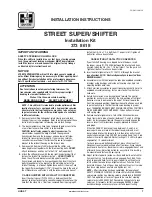
off until the tire pressure is at or above the recommended
cold placard pressure. Once the low tire pressure warn-
ing (Tire Pressure Monitoring Telltale Light) illuminates,
you must increase the tire pressure to the recommended
cold placard pressure in order for the “Tire Pressure
Monitoring Telltale Light” to turn off. The system will
automatically update and the “Tire Pressure Monitoring
Telltale Light” will turn off once the system receives the
updated tire pressures. The vehicle may need to be
driven for up to 20 minutes above 15 mph (24 km/h) in
order for the TPMS to receive this information.
For example, your vehicle may have a recommended cold
(parked for more than three hours) placard pressure of
33 psi (227 kPa). If the ambient temperature is 68°F (20°C)
and the measured tire pressure is 28 psi (193 kPa), a
temperature drop to 20°F (-7°C) will decrease the tire
pressure to approximately 24 psi (165 kPa). This tire
pressure is low enough to turn ON the “Tire Pressure
Monitoring Telltale Light.” Driving the vehicle may cause
the tire pressure to rise to approximately 28 psi (193 kPa),
but the “Tire Pressure Monitoring Telltale Light” will still
be on. In this situation, the “Tire Pressure Monitoring
Telltale Light” will turn off only after the tires are inflated
to the vehicle’s recommended cold placard pressure value.
CAUTION!
•
The TPMS has been optimized for the original
equipment tires and wheels. TPMS pressures and
warning have been established for the tire size
equipped on your vehicle. Undesirable system
operation or sensor damage may result when using
replacement equipment that is not of the same size,
type, and/or style. Aftermarket wheels can cause
sensor damage. Do not use aftermarket tire seal-
ants or balance beads if your vehicle is equipped
with a TPMS, as damage to the sensors may result.
(Continued)
342
STARTING AND OPERATING
Summary of Contents for 2011 Dodge Nitro
Page 1: ...Nitro O W N E R S M A N U A L 2 0 1 1 I n f o r ma t i o nP r o v i d e db y ...
Page 5: ...I n f o r ma t i o nP r o v i d e db y ...
Page 9: ...6 INTRODUCTION I n f o r ma t i o nP r o v i d e db y ...
Page 95: ...I n f o r ma t i o nP r o v i d e db y ...
Page 128: ...3 UNDERSTANDING THE FEATURES OF YOUR VEHICLE 125 I n f o r ma t i o nP r o v i d e db y ...
Page 129: ...126 UNDERSTANDING THE FEATURES OF YOUR VEHICLE I n f o r ma t i o nP r o v i d e db y ...
Page 130: ...3 UNDERSTANDING THE FEATURES OF YOUR VEHICLE 127 I n f o r ma t i o nP r o v i d e db y ...
Page 195: ...I n f o r ma t i o nP r o v i d e db y ...
Page 283: ...280 UNDERSTANDING YOUR INSTRUMENT PANEL I n f o r ma t i o nP r o v i d e db y ...
Page 289: ...I n f o r ma t i o nP r o v i d e db y ...
Page 331: ...328 STARTING AND OPERATING I n f o r ma t i o nP r o v i d e db y ...
Page 401: ...I n f o r ma t i o nP r o v i d e db y ...
Page 449: ...I n f o r ma t i o nP r o v i d e db y ...
Page 476: ...INDEX 10 I n f o r ma t i o nP r o v i d e db y ...
Page 495: ...492 INDEX I n f o r ma t i o nP r o v i d e db y ...
















































